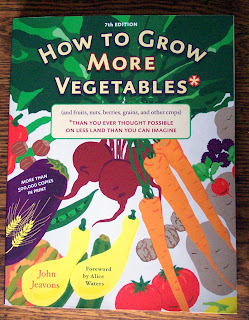I'm following the guidelines set out by John Jeavons in his book How to Grow More Vegetables. Jeavons recommends a "double dig" to build soil quality. It works like this: Before you start your dig, you loosen the soil and dress it with a half inch layer of compost--it it needs it. I didn't have compost, so I purchased 6 bags of MiracleGro organic garden soil. I'm on my way to the $64 dollar tomato. (There's a book with that title--I plan to read it next.)
Anyhow, when you are ready to dig, you start at one end of your garden and dig a trench 12" deep. Yeah right. 9 inches down (I measured) I said "Looks good to me." We put the dirt we removed into a wheel barrow.

You dig the trench while standing on a board positioned next to the trench. Once you remove the dirt from the trench, you loosen the floor of the trench you just dug using a d-handled spading fork. Supposedly 12" deep again (for a total of 24"). Hmmm, I don't think so. I will say the d-handled spading fork was the only thing that worked the way the book said it would.

After you finish digging a trench, you move the board back 12" and push the 12 inches you've just uncovered down into the trench you just dug. Well, theoretically. Of course, in reality when you push that dirt forward into the trench you just dug, you still have to do more digging to create a new trench. The question is, Where do you put that dirt? According to How to Grow More Vegetables, you shouldn't be turning the earth so much as pushing it from one trench to another. We just never figured out how to do this. So the double dig is intended to keep the earth on the same level it was originally: supposedly you just move it and aerate it. But we ended up turning ours. Like I said, it's like manually rototilling your garden
 Eventually, we got a bit of a rhythm down. My husband would dig. Then I would loosen the soil in the bottom of the trench with the spading fork. Then he would dig some more. The biggest problem was tree roots. We have lots of trees in our backyard and I think we were bumping into the end of their root systems. I'm not sure what this will mean for the garden. In any case we did end up with a garden ready for planting, although I'm not sure it can be legitimately described as double dug.
Eventually, we got a bit of a rhythm down. My husband would dig. Then I would loosen the soil in the bottom of the trench with the spading fork. Then he would dig some more. The biggest problem was tree roots. We have lots of trees in our backyard and I think we were bumping into the end of their root systems. I'm not sure what this will mean for the garden. In any case we did end up with a garden ready for planting, although I'm not sure it can be legitimately described as double dug.You can see that it did make a difference. The first picture shows us at the halfway mark and the picture on the bottom shows the finished product. As a last step before planting, I watered and fertilized with more MiracleGro--this time organic fertilizer. I never did receive my soil report so I decided to go with the tried and true. My grandmother swore by MiracleGro, or she would have if she had been the type of person to swear. And if she had double dug a garden, she might have had to resort to swearing.


Gardens are trendy right now. Everybody's jumping on the bandwagon. They even broke ground on a vegetable garden at the White House this week. It's the first, I believe, since the World War II era victory gardens. But not many people talk about how much work it is. The drawings in the book How to Grow More Vegetables (notice drawings, not photographs) show neat, straight lines in the trenches--drawn with a ruler, no doubt--and a nicely dressed, non-sweaty man daintily moving the earth. I'm ok with the hard work, especially since my husband is a maniac and did most of it, but unless you have hired muscle, be prepared for some really hard work if you undertake double digging.
As a side note, I'm wondering how anyone has time to both cultivate a garden and blog about it and have a real job. My respect for TennZen grows exponentially.
Next time...the adventure of planting!


